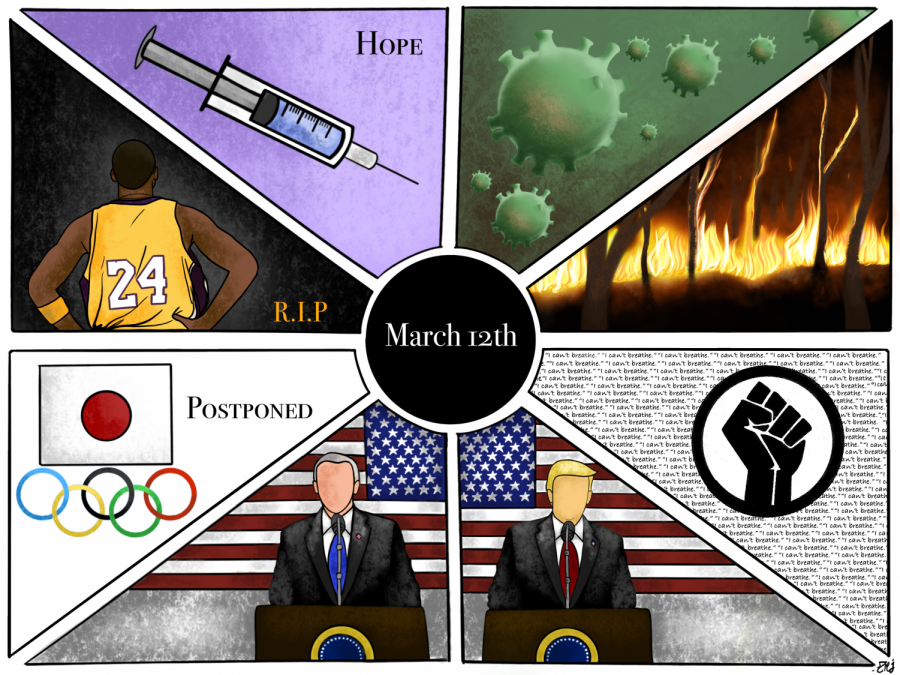March 12th: Reflecting On One Year Since Harriton’s Shutdown
A huddled group of unmasked writers stares at the whiteboard, spitting out ideas for the weekly Banner brainstorm.
One voice suggests, “Let’s write about the coronavirus.”
Another adds, “Oh yeah, the disease in Asia, right?”
At the whiteboard, a writer jots down the idea: “Coronavirus. Is that one or two words?”
It was the end of February 2020. Up to this point, The Banner had published one article that warned of America underestimating the coronavirus. Otherwise, COVID-19 was a rumor in the halls, a faraway phenomenon occurring on another continent.
We felt untouchable.
Yet, just weeks later, on March 12th, we were running out of the Harriton building, slightly panicked about the virus but mainly looking forward to a brief recess from our tiring schedules. And in those first few days at home, many of us found comfort in not understanding what the virus was or how it would affect us.
At the time, it was two weeks off from school; two weeks to make the viral whipped coffee, watch the tiger docu-series that your uncle could never remember the title of, and learn the TikTok dance to “Supalonely.”
By Spring Break, however, most of us grew tired of the hour-long family walks and the unstructured schedules, which made hours feel like days. The seniors learned that prom was canceled, juniors realized that they still had to study for the online AP tests, and all students reckoned with the idea that they might not see their friends or teachers in-person for the rest of the school year.
COVID-19 became a tangible fear, as cases in Montgomery County rocketed. Many of us began to recognize neighbors and family members on the growing list of victims.
Locked indoors and suffocated by endless news reports on the virus’s deathly threat, students escaped reality through social media. Even the most fervent TikTok haters had downloaded the app by April, and teenagers reverted to all-night FaceTime calls and Instagram scrolls in place of their usual weekend plans.
At the end of May, when the deaths of George Floyd and Ahmaud Arbery went viral, those escapist routes became a conduit for a social movement. The underlying racial tension in America had reached its tipping point, and an influx of outspoken young activists turned to social media to voice their opinions.
What was once (and granted, still is) a place to flaunt lush vacations and weekend outings morphed into an activism hotspot, where young users promote equality, educate each other, and spread awareness on issues that matter.
In the last 365 days, the confluence of political strife, calls for systemic reform, and the pandemic has molded our generation into one that is now defined by its outspokenness. But while activism on social media has given some a platform for their voice, it has overshadowed the isolation felt among many students.
The return of classes for the 2021 school year did not ease this feeling of loneliness and instead added another layer of anxiety and new responsibilities. Unlike the usual freshmen experience, which stimulates social interaction and extracurricular involvement, the Harriton ninth graders had to navigate this change in a virtual and physically distanced setting.
For the seniors, the quarantine amplified college application stress and stole the end-of-year joyride that would have compensated for a challenging first semester.
Now, as we sit in front of our screens for another virtual Banner meeting, we plan an article about Harriton’s full return to school at the end of March. This news arrives on the heels of breaking advancements in vaccine distribution and a consistent decrease in nationwide deaths. We might finally achieve some normalcy.
But, just as we thought the quarantine would last two weeks, it would be a mistake to think our last two months of the school year will grant us the “normal” closure that it does in other years. After all, we cannot expect regularity when we’ve been forced to adapt to the waves of social turmoil and uncertainty that have crashed on us in the last year.
So, as we move past the quarantine’s one-year anniversary, we should acknowledge this adversity while appreciating our present growth and remaining optimistic about the future. Hope is on the precipice, yet we must remind ourselves that the world waiting for us is not the one that we remember.

Goldie Beck is excited to serve as an Executive Editor for The Harriton Banner. When not writing and editing, Goldie hosts her HarritonTV series Herd It...

Harriton senior Ty Nagvajara is very excited to become the Co-Executive Editor for The Harriton Banner this year. Last year he worked as the Arts &...

This is Trinidad Monteagudo Jackson's second year at The Harriton Banner, and is super excited about creating new graphic designs for articles. She...


